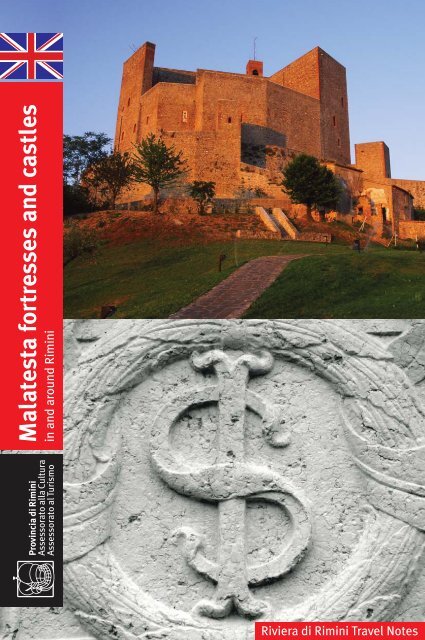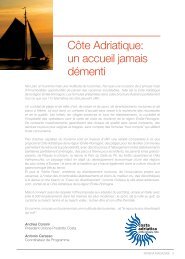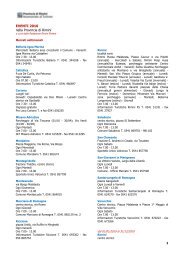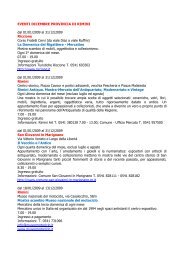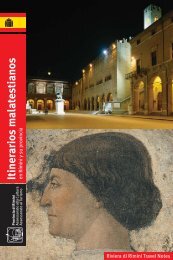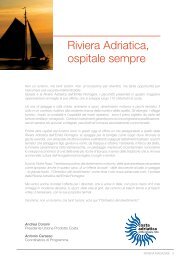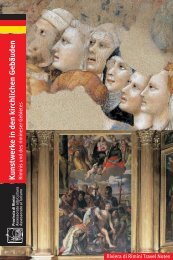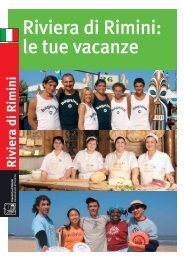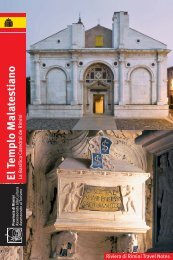Malatesta fortresses and castles
Malatesta fortresses and castles
Malatesta fortresses and castles
- No tags were found...
You also want an ePaper? Increase the reach of your titles
YUMPU automatically turns print PDFs into web optimized ePapers that Google loves.
Provincia di RiminiAssessorato alla CulturaAssessorato al Turismo<strong>Malatesta</strong> <strong>fortresses</strong> <strong>and</strong> <strong>castles</strong>in <strong>and</strong> around RiminiRiviera di Rimini Travel Notes
RiminiCastel SismondoVerucchio<strong>Malatesta</strong> FortressTorriana<strong>Malatesta</strong> FortressMontebelloGuidi di Bagno FortressSantarcangelo di Romagna<strong>Malatesta</strong> FortressCoriano<strong>Malatesta</strong> Antiquarium Castle del Castello AntiquariumMondaino<strong>Malatesta</strong> FortressMontefiore Conca<strong>Malatesta</strong> FortressGradaraFortressSan LeoRenaissance FortressPennabilliRuins
Provincia di RiminiAssessorato alla CulturaAssessorato al TurismoAgenzia marketing turistico Riviera di RiminiPier Giorgio Pasini<strong>Malatesta</strong> <strong>fortresses</strong> <strong>and</strong> <strong>castles</strong>in <strong>and</strong> around RiminiIn collaboration with
Coordination:Valerio LessiGraphic Design:Relè - Leonardo SonnoliPhotographs takenfrom Rimini ProvincePhotograph ArchivesWith thanks to the photographers:L. Bottaro, P. Cuccurese, P. Delucca,S. Di Bartolo, L. Fabbrini, R. Gallini,L. Liuzzi, G. Mazzanti, T. Mosconi,Paritani, V. Raggi, E. Salvatori,R. Sanchini, F. Taccola, R. UrbinatiTranslation:Gillian Forlivesi Heywood,Link-Up, RiminiRevision by:Marino Campana, Caterina PolcariPage Layout <strong>and</strong> structure:Litoincisa87, RiminiLicia RomaniFirst Edition 2003Reprinted 2008
ContentsIntroduction >Itinerary 1 >5 The Territory of Rimini8 The Defences of the <strong>Malatesta</strong> State12 Rimini CastleItinerary 2 >Itinerary 3 >16 The Cradle of the <strong>Malatesta</strong> Dynasty:Pennabilli <strong>and</strong> Verucchio19 The Marecchia ValleyItinerary 4 >26 The Conca ValleyItinerary 5 >34 Palaces for the Holidays: Montefiore <strong>and</strong> GradaraBibliography >40 Further Readingwww >Before you leave home, visit our sitewww.riviera.rimini.it
Introduction > The Territory of RiminiAbove, the cliff of Pietracutaseen from the Marecchiariver bed. Below, view of theMarecchia valley showingMontebello castle <strong>and</strong> village.5The territory around Rimini is flat only in part. Covignano Hillst<strong>and</strong>s guard immediately at the back of the town, <strong>and</strong> only a littlefurther away is Mount Titano, a forward sentry of the Apennine hillsto the south.The hilly countryside is enlivened by numerous torrentialstreams with broad gravel beds. Two of these are notable: theMarecchia, which rises in Tuscany, close to the source of the Tiber,in the hills known as Alpe della Luna; <strong>and</strong> the Conca, which rises inthe Montefeltro region, on the slopes of Mount Carpegna. Thevalleys <strong>and</strong> conoids of these two rivers, separated <strong>and</strong> kept apartby Mount Titano, make up the territory of Rimini, tapering gently offinto the Lombard Plain on the one h<strong>and</strong> <strong>and</strong> wedged tightlybetween the Adriatic sea <strong>and</strong> the Apennine hills on the other,bordering on Le Marche <strong>and</strong> the Montefeltro region.Montefeltro has its own special character <strong>and</strong> history,stemming partly from the morphology of the terrain, essentiallyhilly <strong>and</strong> mountainous, <strong>and</strong> partly from one particular diocese, theMontefeltro diocese, which held sway here from at least the sixthor seventh century onwards; in mediaeval times the jurisdiction ofthe diocese extended as far as the Savio <strong>and</strong> Foglia valleys,occupying a strategic position as regards communications betweenthe Lombard Plain <strong>and</strong> the central <strong>and</strong> southern regions of theItalian peninsula. Ever since the early Middle Ages, Montefeltro hasbeen a region of strong sectarian interests, making true political<strong>and</strong> administrative unification impossible; <strong>and</strong> so the variouscommunities within the region guarded their autonomy down thecenturies, aided by the absence of any central power capable ofsubjugating <strong>and</strong> organising them. It is significant that until theseventeenth century the diocese of Montefeltro did not have astable See: San Leo, San Marino, Talamello, Montetassi, ValleSant’Anastasio <strong>and</strong> Pennabilli were all at one time or anotherhome to the Bishop of Montefeltro, <strong>and</strong> sometimes to hischancellery <strong>and</strong> his court of law as well. One of these communities,owing to a series of favourable circumstances, has kept itsautonomy right down to the present day: the Republic of SanMarino, which belongs to the diocese of Montefeltro <strong>and</strong> whichthroughout its long history has always leaned more towards Urbino<strong>and</strong> Le Marche than towards Rimini <strong>and</strong> the Romagna region.The road through the Marecchia valley crosses the Apenninesby the easily accessible pass of Viamaggio <strong>and</strong> leads into Tuscany<strong>and</strong> thence to the Tyrrhenian sea: this has made the valley a placeof importance ever since ancient times. There were settlements
Introduction > The Defences of the <strong>Malatesta</strong> State8Ever since Roman times, Rimini has held sway over a broadbelt of l<strong>and</strong>, both in the plain towards Romagna <strong>and</strong> in the hillstowards Le Marche. In the Middle Ages the City-State of Riminifound itself in conflict with the various possessions of the localChurch, the Church of Rome, <strong>and</strong> the Church of Ravenna, <strong>and</strong> alsowith the numerous concessions made to monasteries <strong>and</strong> wealthyl<strong>and</strong>owners by the Archbishop of Ravenna, the Pope, <strong>and</strong> theEmperor. From the twelfth century onwards, the supremacy ofRimini over the surrounding hill country was threatened by the<strong>Malatesta</strong> family, who from their seats in Pennabilli <strong>and</strong> Verucchiowere able to keep a hold over the middle Marecchia valley, alreadydominated in its upper part by the Carpegna <strong>and</strong> Montefeltrofamilies.Conflict <strong>and</strong> concord followed one another repeatedly, untilfinally the <strong>Malatesta</strong> family took over as rulers of Rimini in thefourteenth century, <strong>and</strong> governed it in the office of Vicars of theHoly See from 1355 until the end of the fifteenth century. Foralmost two centuries the history of Rimini <strong>and</strong> the history of the<strong>Malatesta</strong> dynasty were one <strong>and</strong> the same, <strong>and</strong> the <strong>Malatesta</strong>family extended their dominion over the surrounding l<strong>and</strong>s: in LeMarche, as far as Ascoli Piceno, in Tuscany as far as Borgo SanSepolcro, <strong>and</strong> in Romagna as far as Cesena; but they neversucceeded in getting rid of their most shrewd <strong>and</strong> powerfulneighbours, the Montefeltro family. The Montefeltro dynastyprobably owed its origins, like the <strong>Malatesta</strong>, to possessionscarved out of the l<strong>and</strong>s belonging to the earldom of Carpegna,feudatories of ancient Imperial origin who ruled Mount Carpegna<strong>and</strong> much of the region. The conflict between the <strong>Malatesta</strong> <strong>and</strong> theMontefeltro families became especially bitter in the mid-fifteenthcentury when the heads of the two rival families were respectivelySigismondo <strong>and</strong> Federico, especially when Federico succeeded ininstalling his son-in-law Aless<strong>and</strong>ro Sforza as ruler of the city ofPesaro <strong>and</strong> its surrounding l<strong>and</strong>s, in 1445. Until then, Pesaro hadbeen a <strong>Malatesta</strong> possession, belonging to Sigismondo’s cousin,the inept Galeazzo <strong>Malatesta</strong>. This new state of affairs gave theterritory of Urbino access to the sea while at the same time cuttinginto two separate sections the territory of Sigismondo, which at thetime extended into Le Marche as far as Fano, Senigallia <strong>and</strong>Fossombrone.The Marecchia <strong>and</strong> Conca valleys provide many examples ofmilitary architecture from the twelfth to the fifteenth centuries.Villages fortified to a greater or lesser extent alternate with stout
9<strong>fortresses</strong> capable of containing a small garrison <strong>and</strong> with lookouttowers, isolated or surrounded at most by a small enclosure, whichserved to keep watch over the surrounding territory <strong>and</strong> to sendsignals. The constructions which have survived to the present day,however, have almost all been much altered or reduced to barelylegible ruins. It must be remembered that numerous as thesesurvivors are, they are nevertheless only a very small part of asystem which had already reached its apogee of size <strong>and</strong> efficiencyin the 1470s, when the territory was protected by a completenetwork of fortifications. The insecurity of the State regarding itsenemies both within <strong>and</strong> without had compelled it to fortify everyspot of any strategic importance, not simply the borders, which inany case were always ill-defined <strong>and</strong> often subject to unforeseen<strong>and</strong> sometimes substantial changes.The <strong>Malatesta</strong> rulers continually altered their fortifications tomake them more secure <strong>and</strong> to bring them into line with newmethods of combat <strong>and</strong> siege. The period of major transformationwas undoubtedly the rule of Sigismondo, partly because thisperiod also coincided with the more frequent <strong>and</strong> massive use of anew <strong>and</strong> terrible weapon: artillery. Sigismondo became ruler ofRimini in 1432, when he was barely fifteen years old, <strong>and</strong> beganalmost immediately to restore <strong>and</strong> improve the fortifications of histerritory: Marco Battagli, in his Chronicle written at the same time,wrote admiringly of Sigismondo “Even from his adolescence heperfected that which an entire generation could hardly haveaccomplished.” These works were intended to make the militaryconstructions truly functional, not “beautiful”; or rather, to givethem not abstract beauty but the beauty of complete coherence,where every part of the construction was perfectly suited to itsmilitary purpose.A practical mind, especially well versed in the art of war,inventor of new explosive devices: this was Sigismondo, accordingto Roberto Valturio; <strong>and</strong> Sigismondo personally took aconsiderable part in designing <strong>and</strong> modernising the defences of hisState. But he did ask for advice from others, <strong>and</strong> in 1438 heobtained Filippo Brunelleschi as supervisor for all the work then inprogress in his territory, both in Romagna <strong>and</strong> in Le Marche. InMarch 1454 Leon Battista Alberti also came to see the <strong>Malatesta</strong>fortifications, together with Matteo de’ Pasti; it is certain that hevisited Senigallia (a town “re-founded” by Sigismondo, then beingbuilt), <strong>and</strong> he probably made a wide reconnaissance of the<strong>Malatesta</strong> l<strong>and</strong>s.
The fortifications restored or rebuilt by Sigismondo alwayshave steeply sloping scarp walls, a certain irregularity of extensionin the outer walls, <strong>and</strong> towers <strong>and</strong> bastions interesting not so muchfor their height as for their polygonal design, precursors of theround bastions which would be the most noticeable <strong>and</strong> mostmodern conceptual innovation of the last quarter of the century.Further partial innovations can be found in the shrewd use oframparts, for the outer defences <strong>and</strong> at times even in the innerwards, where they served to facilitate passage, giving thedefenders more room for manoeuvre <strong>and</strong> enabling them tobarricade themselves in case of invasion.These innovations do not usually go against tradition asregards the overall outward appearance of the fortifications: tall,solid, square; made more picturesque by the addition of towers,merlons <strong>and</strong> corbels (rather like all the <strong>castles</strong> of the LombardPlain). They have a gr<strong>and</strong>eur typically mediaeval <strong>and</strong> areexceptionally evocative, partly owing to the harsh wild beauty ofthe places where they st<strong>and</strong>, places chosen very carefully, to forman uninterrupted chain of strongholds. Guarding <strong>and</strong> watching, onenext to the other, one over the other, always within sight of oneanother; they make a formidable chain of defences seeminglyturning their attentions especially towards Montefeltro <strong>and</strong> SanMarino.Of course, almost all these places had been fortifiedpreviously; but Sigismondo was responsible not only for therationalisation of the single defences, but also for a complete <strong>and</strong>thorough overall defensive project, where some of the old <strong>castles</strong>were neglected or much reduced, while others were rebuilt orenlarged <strong>and</strong> connected to one another so as to form a system. Inthis sense, it can be said that Sigismondo re-founded theorganisation of the defence of the State; it must also be said thathe never failed to point this out in the various epigraphs walledinto his many <strong>castles</strong>, all of which boasted that he had built them afundamentis, from the foundations, even when really he had onlymodernised them.Above: the <strong>Malatesta</strong> fortressin Mondaino, now the TownHall. Below: a portrait medalof Sigismondo P<strong>and</strong>olfo<strong>Malatesta</strong> (c. 1450).11
Itinerary 1 > Rimini CastleRiminiCastel Sismondopiazza <strong>Malatesta</strong>tel. 0541 351611 (FondazioneCassa di Risparmio)fax 0541 28660www.fondcarim.itsegreteria@fondcarim.itAbove: Castel Sismondo,Rimini (1437-1446).Below: <strong>Malatesta</strong> medalshowing a view of CastelSismondo (c. 1450).12Rimini Castle is the undisputed masterpiece of <strong>Malatesta</strong>military architecture. Commissioned by Sigismondo in 1437, it wasfinished in 1446, according to the epigraphs with which it is adorned.Their solemn dictation <strong>and</strong> ancient epigraphic style inform the visitorthat the Ruler of Rimini wished to name his castle, which he as usualclaimed to have built a fundamentis, after himself: Castel Sismondo.The construction made use of considerable parts of pre-existingthirteenth-century <strong>Malatesta</strong> dwellings <strong>and</strong> also of the fortificationswhich Sigismondo’s predecessor (his brother Galeotto Roberto,known as The Blessed) had built. To Sigismondo, this castle wasmuch more than just his palace: it was intended to be the visualsymbol of his power, in keeping with a wholly traditional concept,<strong>and</strong> he had it built in the traditional style, more expressivelypicturesque than rationally harmonious, as can be seen from thevariable perspective of the towers, the solidity of the curtain wallssurmounted with merlons, the frequent use of pointed arches <strong>and</strong>stone or ceramic inserts, <strong>and</strong> the splendour of the gilding <strong>and</strong> of thepargetry coloured in red <strong>and</strong> green, the heraldic colours of the<strong>Malatesta</strong>s, all of which were described by contemporary writers. Thetraditional picturesque style continued in the interior, in the tortuouspassageways, the irrational layout of certain rooms, <strong>and</strong> perhaps tooin the scarcity of large reception rooms.To get an idea of the castle’s original appearance today, one hasto refer to the medals cast by Matteo de’ Pasti to celebrate itsconstruction, <strong>and</strong> to a detail of the fresco by Piero della Francesca inthe <strong>Malatesta</strong> Temple (the Cathedral of Rimini), which shows thedesign exactly; or to a page of De Re Militari by Roberto Valturiodedicated to the description <strong>and</strong> praise of this construction <strong>and</strong> ofSigismondo. The inner nucleus of the castle was distinguished by fivetowers which surrounded a tall keep (the palatium);the broad moatwhich marked the outer circuit of the walls extended into the presentPiazza <strong>Malatesta</strong> as far as the rear of the nineteenth-century theatre.The castle’s immense size, mighty appearance <strong>and</strong> irregularshape, designed as a series of fortified enclosures surroundingcentral living quarters, make it striking even today. Someirregularities of design can be explained by the exploitation,necessary or convenient, of pre-existing structures: some, but notall. For example, the positioning of the towers may be attributed inpart to this rationale, but can be also partly seen as an attempt -early <strong>and</strong> so rather uncertain - to create a system of defences withshooting <strong>and</strong> observation points which were to st<strong>and</strong> side by side<strong>and</strong> support one another; a necessity much felt since the
Above: <strong>Malatesta</strong> woodenchest (c. 1450) fromMontegridolfo, now in the CityMuseum, Rimini. Below:interior of Castel Sismondoduring a <strong>Malatesta</strong> exhibition.15introduction of artillery.An inventory drawn up immediately after the death ofSigismondo gives an idea of the furnishings of the residential part ofthis great construction: tables, benches <strong>and</strong> chests, beds <strong>and</strong>wardrobes, tapestries <strong>and</strong> hangings, were all noted <strong>and</strong> numberedby the notary who on the 13 th day of October 1468 toured <strong>and</strong>inventoried rooms great <strong>and</strong> small, rooms bearing picturesquenames deriving in part from their mural decorations – the Garl<strong>and</strong>Chamber, the Juniper Chamber, the Death Chamber, the Chamber ofthe Crucifix. The chests <strong>and</strong> wardrobes contained books <strong>and</strong> writtendocuments, jewellery <strong>and</strong> garments in strange styles often madefrom precious fabrics, bed covers <strong>and</strong> linen. In the store-rooms wereweapons, banners, tents <strong>and</strong> st<strong>and</strong>ards, horse harness <strong>and</strong> dogcollars, equipment for traditional hunting (bows <strong>and</strong> arrows) <strong>and</strong> formodern warfare (mortars <strong>and</strong> bombards).All of this has been lost. The only authentic piece of furnituresurviving from <strong>Malatesta</strong> times is a small cypress-wood chestdatable to the mid-fifteenth century richly carved withSigismondo’s coat of arms among decorative motifs. It comes fromthe castle of Montegridolfo, <strong>and</strong> is now in the city museum.With the fall of the <strong>Malatesta</strong> dynasty at the end of thefifteenth century, Castel Sismondo ceased to be a princelyresidence <strong>and</strong> was used for purely military purposes; with thepassing of time it had to be altered as defensive needs dictated,especially for defence from firearms, which had made enormousprogress in just a few decades. In the seventeenth century, afterthorough restoration work <strong>and</strong> the inclusion of additionalembrasures, it took the name Castel Urbano, in honour of thereigning Pope, Urban VIII. It was subsequently used as a barracks,a storehouse, <strong>and</strong> finally a prison.It is destined to become a cultural centre, <strong>and</strong> has been thesubject of restoration work for some time. These works haveuncovered a number of pre-existing constructions; one especiallyinteresting find is the remains of the Roman city walls with agateway, incorporated in the foundations of the castle; this wasprobably the late-Roman Porta Montanara, the “mountain gate”,which in the Middle Ages was replaced by another gate, in thesame place but at a higher level, known as the Porta del Gattolo.This gate belonged to the bishopric throughout the thirteenthcentury, that is until it fell into the h<strong>and</strong>s of the <strong>Malatesta</strong> family,whose dwellings were close by.
Itinerary 2 > The Cradle of the <strong>Malatesta</strong> Dynasty:Pennabilli <strong>and</strong> VerucchioVerucchioRocca Malatestianavia Rocca, 42tel. 0541 670222fax 0541 673266www.prolocoverucchio.itiat.verucchio@iper.net• open all yearFacing page: Rocca del Sasso,the <strong>Malatesta</strong> fortress ofVerucchio.16There is documentary evidence that the <strong>Malatesta</strong> familypossessed l<strong>and</strong>s in the territory around Rimini from the twelfthcentury onwards, especially in the Marecchia <strong>and</strong> Conca valleys,from the hills of Rimini to the promontory of Gabicce. Their history,however, is uncertain until they became citizens of Rimini, acentury later. About the year 1220 <strong>Malatesta</strong> “dalla Penna”emerged as head of the family; he was succeeded after his death inabout 1247 by his son <strong>Malatesta</strong> “da Verucchio”. Penna(Pennabilli) <strong>and</strong> Verucchio dispute the honour of being thebirthplace of the <strong>Malatesta</strong> dynasty. In past centuries localscholars, at times basing their premises on false diplomas, havespilled rivers of ink to argue the question, which is certainly not offundamental importance. Probably Verucchio was just anotherstage on the road which led eventually to the city for the ever morepowerful <strong>and</strong> ever more wealthy family. Whatever the truth, the“cradle” of the <strong>Malatesta</strong> dynasty was somewhere in the middleMarecchia valley, unless it was even higher up the valley inTuscany (where it appears there may be traces even older,although still very uncertain, as Currado Curradi has recentlysuggested).Pennabilli <strong>and</strong> Verucchio are similar in structure. Both extendalong a saddle crossed by a road <strong>and</strong> both overlook the riverMarecchia with two <strong>castles</strong> each. Of the Pennabilli <strong>castles</strong> only afew almost shapeless ruins remain, with traces of cisterns,crowning the two peaks known as Il Roccione (the great rock) <strong>and</strong>La Rupe (the crag) which were home to two separate villages,Penna <strong>and</strong> Billi, unified in the fourteenth century. Traces of apolygonal bastion on the Great Rock suggest a fifteenth-century<strong>Malatesta</strong> construction, while the remains of fortifications on theCrag form part of the convent of the Augustinian nuns, built at thebeginning of the sixteenth century from the stones of thedemolished fortress. In the village, remains of the outer walls canstill be seen, together with two gateways, both altered, bearing thecoats of arms of the <strong>Malatesta</strong> <strong>and</strong> Montefeltro families. These bearwitness to the transfer of the town from <strong>Malatesta</strong> to Montefeltrorule, which became definitive in 1462, the year before the finaldefeat of Sigismondo <strong>Malatesta</strong> by the Papal troops under thecomm<strong>and</strong> of Federico da Montefeltro.In some ways Verucchio was more fortunate. Here too, one ofthe <strong>castles</strong> (Rocca del Passerello) was almost completelydestroyed <strong>and</strong> became a nuns’ convent, but the other castle, Roccadel Sasso, still st<strong>and</strong>s: staunch <strong>and</strong> visible from far away, it
18dominates the town <strong>and</strong> the surrounding countryside. Althoughmuch altered <strong>and</strong> restored it nevertheless remains one of the mostinteresting of the Marecchia valley <strong>castles</strong>, together withMontebello, San Leo <strong>and</strong> Santarcangelo. Sigismondo fortified it in1449, as two fine inscriptions record, adding a huge scarp <strong>and</strong>rearranging the edifices around a massive central keep.Excavations have revealed capacious underground passages <strong>and</strong>imposing construction work dating perhaps from the twelfthcentury, certainly much earlier than Sigismondo’s work. The finesquare stone tower, partly solid <strong>and</strong> with an exceptionally preciseface, is older too. Recently (in 1975) an ancient pathway wasunexpectedly reconstructed. This led steeply down the side of thecliff where the castle st<strong>and</strong>s, <strong>and</strong> was shielded by the castle keep;it served as a link with the surrounding territory in case ofemergency. The rooms of the castle have been much altered <strong>and</strong>transformed, first to adapt them to the needs of the small courts ofthe various rulers who held Verucchio in fief from 1518 to 1580:Zenobio de Medici, Ippolita Comnena, Leonello <strong>and</strong> Alberto Pio daCarpi; <strong>and</strong> finally to accommodate a small theatre built in theinterior of the castle in the eighteenth century.As with Pennabilli, so with Verucchio: lost by Sigismondo in1462 after an exhausting siege. Rocca del Sasso, well fortified <strong>and</strong>defended by troops faithful <strong>and</strong> devoted to their lord, had nointention of surrendering to Federico da Montefeltro, who foundhimself compelled to resort to one of those stratagems of which hewas a master: a letter bearing the forged signature of <strong>Malatesta</strong>Novello, announcing the imminent arrival of reinforcements. Thereinforcements duly arrived, <strong>and</strong> only when it was too late did thecastellan realise that they were in fact Federico da Montefeltro’ssoldiers in disguise.Verucchio overlooks the river <strong>and</strong> all the plain as far as Rimini,keeps watch over much of the territory of San Marino, <strong>and</strong>communicates directly with the castle of Scorticata (now re-namedTorriana) which st<strong>and</strong>s opposite, <strong>and</strong> with the <strong>castles</strong> on the plainof Rimini. Its position, highly strategic for keeping control over theterritory, explains the pains taken by Sigismondo to improve <strong>and</strong>strengthen its defences, which today are peaceful balconies givingstunning views over one of the most picturesque <strong>and</strong> enchantingl<strong>and</strong>scapes in the world, “a mixture of valleys, mountains, plain,villas, <strong>and</strong> sea”, as Monsignor Gian Maria Lancisi, chief physician toPope Clement XI, wrote in 1705.
Itinerary 3 > The Marecchia ValleySan LeoRenaissance Fortressvia Btg. Cacciatoritel. 0541 926967-916306musei.san-leo@provincia.ps.it• open all year19The territory between Pennabilli <strong>and</strong> Verucchio still has manyinteresting tokens of art <strong>and</strong> history. At the foot of the hill ofPennabilli, between the present road <strong>and</strong> the river Marecchia,st<strong>and</strong>s the twelfth-century Romanesque Pieve, or parish church, ofSan Pietro in Messa, built entirely of stone. The interior has a nave<strong>and</strong> two side aisles, <strong>and</strong> there is a fine façade. In the year 1200Giovanni <strong>Malatesta</strong> gave some l<strong>and</strong> to this church.On the other side of the river is the fascinating village ofPetrella Guidi, almost uninhabited today but still showing intact itsmediaeval structure, dominated by a ruined castle with a hugetower built by the Tiberti family in the twelfth <strong>and</strong> thirteenthcenturies. In many places on the walls of this tower its originalwhite plasterwork can still be seen, proof that these ancientfortifications were pargeted <strong>and</strong> painted, usually with the heraldiccolours of the families who owned them, making them clearlyvisible in the surrounding l<strong>and</strong>scape. The gateway in the castle wallhas a <strong>Malatesta</strong> coat of arms, that of Galeotto <strong>Malatesta</strong>, <strong>and</strong> nextto it the coat of arms of the Oliva family, who held it under<strong>Malatesta</strong> protection until the beginning of the fifteenth century,<strong>and</strong> a Church coat of arms (crossed keys).The little road beyond Petrella leads over the crest of the hillto Sant’Agata Feltria in the Savio valley, where there is a beautiful<strong>Malatesta</strong> castle built on a huge crag known as “Sasso del Lupo”,the rock of the wolf. This castle was altered first by Federico daMontefeltro, who added a bastion designed by Francesco diGiorgio Martini, <strong>and</strong> subsequently by the last feudatories, theFregoso family, who built additional storeys on to the existingcastle.Following the Marecchia valley from Pennabilli down towardsRimini <strong>and</strong> the sea, on the right after Novafeltria can be seenMount Maioletto, where st<strong>and</strong> two polygonal bastions <strong>and</strong> acurtain wall, all that remains of a <strong>Malatesta</strong> castle destroyed in1639 by a lightning bolt which struck the gunpowder store. Maiolo,the fortified village on the hillside in the shadow of the castle, wasfought over at various times by the Faggiola family, the Bishop ofMontefeltro, the Church, the <strong>Malatesta</strong> family, <strong>and</strong> the Montefeltrofamily, before it was completely destroyed by a l<strong>and</strong>slide on May29 th 1700, leaving a gash still clearly visible on the hillside.A little further on, the level road which follows the broad riverbed gives a magnificent view of San Leo, built on a rocky limestonecrag <strong>and</strong> dominated by an almost impregnable fortress rebuilt byFrancesco di Giorgio Martini for Federico da Montefeltro. San Leo,
Torriana<strong>Malatesta</strong> Fortressvia Castello, 15tel. 0541 675232fax 0541 639905ristoranteduetorri@libero.it• opening times: the exterior<strong>and</strong> surrounding viewpointscan be visitedMontebelloGuidi di Bagno FortressCastello di Montebellotel/fax 0541 675180• open all yearAbove: the fortress of SanLeo. Below: the cylindricaltower of the little church ofOur Lady of Saiano.21the Mons Feretri of ancient times, is in a sense the historic capitalof the Montefeltro region, the origin of the region’s name <strong>and</strong>possible the place of origin of the House of Montefeltro, whofought over it with the Maltesta family throughout the fourteenth<strong>and</strong> fifteenth centuries. San Leo is undoubtedly of great strategicimportance for keeping control over the surrounding territory, <strong>and</strong>was for this reason the object of long-running battles betweenLombards <strong>and</strong> Byzantines. It was in San Leo that the conflictbetween Berengarius II <strong>and</strong> Emperor Otto I came to an end whenthe Emperor succeeded in conquering <strong>and</strong> taking possession of thetown on December 26 th 963, after a lengthy siege. In San Leo thereis genuine, unchanged evidence of the Middle Ages, in the castle<strong>and</strong>, even better, in the Cathedral <strong>and</strong> the ancient Pieve (the parishchurch), magnificent examples of Romanesque architecture.Beside the road which runs alongside the river Marecchia (theStrada Marecchiese), two picturesque crags st<strong>and</strong> guard over thevalley towards Rimini <strong>and</strong> the Romagna region: Pietracuta <strong>and</strong>Saiano. Saiano is a tall rock rising out of the river bed, crownedwith an ancient church dedicated to Our Lady. The church has atrefoil presbytery (with Renaissance frescos, sadly surviving only inpart) reminiscent of the Byzantine “celle tricore”, <strong>and</strong> a huge towerfaced with beautiful s<strong>and</strong>stone ashlars, cylindrical like the belltowersof the Ravenna churches. Cylindrical towers are notuncommon in the Montefelto region, <strong>and</strong> although they follow anancient Roman <strong>and</strong> Byzantine pattern, none of them appears todate from before the thirteenth century. Examples can be found inthe territories of Pennabilli (Maciano), Casteldelci (Torre diMonte), Badia Tedalda (Cicognaia), Montegrimano (Ca’ Manente),Sestino (Monte Romano), <strong>and</strong> Borgo Pace (Torre di San Martino).Just a little further on, almost as if to make a clear boundarybetween Montefeltro <strong>and</strong> Romagna, there st<strong>and</strong>s a fortifiedbarricade: the twin hills of Verucchio <strong>and</strong> Scorticata (now renamedTorriana), on opposite sides of the valley, equipped withdefences intended to make the road impassable. These two <strong>castles</strong>also served for sending to Rimini (using fire <strong>and</strong> smoke as signals)information about the vast territory they were able to survey, bothtowards the sea <strong>and</strong> towards the hills of Romagna <strong>and</strong> Le Marche<strong>and</strong> San Marino. The tower of Scorticata, an outpost of the castle,was able to send messages via the nearby castle of Montebello toSan Giovanni in Galilea, thus activating a whole chain of <strong>castles</strong><strong>and</strong> <strong>fortresses</strong> in the Uso <strong>and</strong> Rubicon valleys <strong>and</strong> in Rimini.It is a good idea to cross the river Marecchia at Ponte
Above: the entrance toTorriana Fortress. Below: awalkway along the outer wallsof Montebello Fortress.22Verucchio <strong>and</strong> follow the road uphill to Torriana <strong>and</strong> Montebello,an attractive village with an interesting castle, much altered by theearls of Bagno, worth visiting both for its architecture <strong>and</strong> for themagnificent views from its terraces overlooking the Marecchia <strong>and</strong>Uso valleys. Then descend the valley keeping to the left of the river,where the l<strong>and</strong>scape is gentle. On the left, in Poggio Berni, isPalazzo Marcosanti, st<strong>and</strong>ing guard over the road on a small hill.This was originally a fortified farm belonging to the <strong>Malatesta</strong>family, <strong>and</strong> part of the original fourteenth-century building can stillbe seen. Notice the attractive escarpment <strong>and</strong> the ogive gatewaysin stone <strong>and</strong> terracotta, in the centre of the main building, alteredin the seventeenth century, <strong>and</strong> the great courtyard.A little further down the valley, where the hills have givenplace to the plain, st<strong>and</strong>s the beautiful thirteenth-century tower -crowned with Ghibelline merlons - of the Battagli, an importantfamily in mediaeval Rimini. This tower served to defend a fortifiedfarm, called a “tomba”, consisting of a walled enclosure withinwhich stood the homes of the farm workers, the stables, <strong>and</strong> - mostimportant - the storehouses for the crops, once gathered in, <strong>and</strong> forthe farm tools. Needless to say, the farm stood at the centre of ahuge country estate.Just a few kilometres away is Santarcangelo, built on a hillbetween the Marecchia <strong>and</strong> Uso valleys. Its unpretentiousarchitecture <strong>and</strong> picturesque narrow streets, climbing the hillside<strong>and</strong> opening into quiet little squares, make this one of the bestpreserved <strong>and</strong> most attractive little towns in the area. The oldestpart is still mostly surrounded by its fifteenth-century walls,restored <strong>and</strong> partly altered in 1447 by Sigismondo, who left behindsome inscriptions in marble. He was responsible too for buildingthe castle which st<strong>and</strong>s at the edge of the hill next to a huge towerbuilt by Carlo <strong>Malatesta</strong> in 1386. This tower was immensely high,<strong>and</strong> according to contemporary writers was considered one of thewonders of Italy for this reason. So imposing <strong>and</strong> so beautiful, itwas still a source of wonder even half a century later; but by thensiege warfare was carried out more often with bronze bombardsthan with wooden catapults, <strong>and</strong> Sigismondo did not hesitate toreduce its height. He used the lower part as the corner keep for anew fortress (partly built from materials reclaimed from thedemolition work), four-sided with polygonal towers, large enoughto contain a fair-sized garrison, in view of the restiveness <strong>and</strong>intolerance of the people of Santarcangelo towards their <strong>Malatesta</strong>overlords, <strong>and</strong> the need to keep constant watch over the lower
Santarcangelo di Romagna<strong>Malatesta</strong> Castlevia Rocca Malatestiana, 4tel/fax 0541 620832tel. 081 5751828www.sigismondomalatesta.itsig.ma@flashnet.it• opening times: in summer,by arrangementMarecchia <strong>and</strong> Uso valleys <strong>and</strong> the Via Emilia close to Rimini.Like many others, this castle too is ornamented with Latininscriptions in beautiful antique script, according to a Humanisticfashion then beginning to spread; sadly, however, it has lostcompletely its crown of merlons <strong>and</strong> corbels. The picturesquecobbled courtyard, covering a mediaeval cistern still in use, givesaccess to the keep, which is the base of Carlo <strong>Malatesta</strong>’s greatfourteenth-century tower, <strong>and</strong> to part of the ancient spiral staircaseconcealed in the huge walls. These stairs allowed independentaccess to the various upper floors, of which four remain. In a room ofthis tower, at dawn on October 10 th 1432, Galeotto Roberto <strong>Malatesta</strong>(known as The Blessed) died at just twenty-one years of age. He wasnephew <strong>and</strong> successor to Carlo <strong>Malatesta</strong>, <strong>and</strong> brother to Sigismondo<strong>and</strong> <strong>Malatesta</strong> Novello. Certain fanciful nineteenth-century writerschose Santarcangelo Castle as the setting for the events which led toGianciotto <strong>Malatesta</strong>’s “crime of honour”, the murder of his wifeFrancesca “da Rimini” <strong>and</strong> his brother Paolo “il Bello”.The terrace of the keep was until recently adorned with a smallcypress tree, most picturesque but a mortal danger to the cohesionof the stonework. From here the view is splendid: the Marecchiavalley opens out to the hills <strong>and</strong> San Marino on one side, <strong>and</strong> toCesena <strong>and</strong> the sea on the other. Near the river, the carefulobserver can see the Pieve, a single-cell Byzantine basilica built inthe sixth century near the Roman settlement. This is the mostancient <strong>and</strong> the best-preserved Pieve in the whole of Romagna.Facing page: the <strong>Malatesta</strong>Castle in Santarcangelo.24
Itinerary 4 > The Conca ValleyCoriano<strong>Malatesta</strong> CastleAntiquariumtel. 0541 657113-659811fax 0541 657469biblioteca@comune.coriano.it• open all yearAbove: two views of CorianoCastle. Below left: themunicipal tower inMontecolombo; below rightthe Peace Church in Trarivi.26From Rimini it is advisable to reach the Conca valley at thebeginning of its hilly part, cutting diagonally across the Riminicountryside as far as Morciano di Romagna. Take the Coriano road,which unfurls soothingly between hills as carefully cultivated as ifthey were gardens: fields, vineyards, olive groves, all follow oneanother along the gentle slopes brightened by scattered farmhouses,little country churches, <strong>and</strong> willow <strong>and</strong> poplar trees growing alongthe banks of the streams which cut deep into the l<strong>and</strong>.In Coriano can be seen the remains of a castle which had scarp<strong>and</strong> curtain walls with corbels, <strong>and</strong> a gateway still bearing clearlyvisible traces of the ancient drawbridge, crowned with the stonecoat of arms of the Sassatelli family of Imola, who held Coriano infief from 1528 to 1580. The inner entrance to the fortified polygonalenclosure is older, <strong>and</strong> consists of an ancient gateway tower, tall<strong>and</strong> straight, topped with a few surviving merlons. Much of thecastle has been restored recently <strong>and</strong> contains an Antiquarium withvarious finds, artefacts <strong>and</strong> ceramic fragments, brought to lightduring the restoration work.Just beyond Coriano a minor road drops steeply down on theleft into the little valley of the Mordano brook, as far asScaricalasino bridge, then climbs sharply up to the hamlet ofCastelleale. This was a fortified farm belonging to Bishop Leale<strong>Malatesta</strong>, who died there in 1400. To the attentive observer, theouter walls of this little huddle of buildings reveal fourteenthcenturywalls <strong>and</strong> arches, ancient windows with stone jambs, <strong>and</strong>the remains of enclosure walls <strong>and</strong> of a tower with a Gothicarchway. On the side towards the hill are substantial remains of thecarriage gateway <strong>and</strong> next to it a smaller gateway for pedestrians,both of an elegant ogival design. Bishop Leale bequeathed to theCathedral of Rimini a fine monstrance, later converted to areliquary for the “Holy Thorn”, on whose base Leale is pictured inprayer before St George, the patron saint of chivalry. On theopposite hill is a settlement similar to Castelleale, possibly evenolder, surrounded by tumbledown walls hidden by vegetation, itsone gateway dominated by a tall tower, half of which collapsed inrecent years: Agello.After Castelleale is San Clemente, where too are the remains offortifications, <strong>and</strong> then the road begins to descend to the Concavalley, which is reached at Morciano. The twisting descent givesviews across the valley to Saludecio, Gemmano <strong>and</strong> Montefiore,fortified villages crowning green wooded hilltops. From Morciano,go up the valley at least as far as Montescudo <strong>and</strong> Montecolombo,
Above: view of Gemmano.Below: view of Morciano.29two well-fortified villages on the left of the river which (together withGemmano) were partially destroyed during the Second World War.In Montescudo, notice the imposing walls of the castle: huge<strong>and</strong> steeply sloping, they made attack practically impossible. On thesouth tower can still be seen a marble plaque with a high-soundingLatin inscription, engraved with the usual attention to the form <strong>and</strong>arrangement of the letters. Sigismondo declares here that he hasbuilt the great castle from the foundations, to serve as a “scudo”,that is to say, a shield, for the town of Rimini. The year: 1460.Montescudo, dominating as it did all the middle Conca valley <strong>and</strong> thevalley of the Marano brook, exactly facing the enemy fortifications ofSan Marino, was truly the keystone of the entire <strong>Malatesta</strong> defencesystem <strong>and</strong> a vital shield for the defence of the city of Rimini, towhich it was connected by a good road along the crest of the hill,barely twenty kilometres long, with no special defences.On March 31 st 1954, restoration work on the east walls ofMontescudo brought to light twenty-two medals bearing the effigyof Sigismondo. These are some of the famous <strong>and</strong> truly magnificentbronze medals cast by Matteo de’ Pasti in the mid-fifteenthcentury. Others have been found elsewhere, always in the walls of<strong>Malatesta</strong> constructions; we know that the Lord of Rimini used tohave them concealed in the walls so that the memory of his name<strong>and</strong> his face would be sure to survive the destruction of what hehad built, just as the memory <strong>and</strong> the effigy of the ancient Romanemperors survived, through their coins, the destruction of eventheir greatest building works. Naturally, such forethought wasincomprehensible to ordinary people, who invented all kinds of fairytales to explain these finds, interpreting them as treasure troves.Various legends concerning treasure hidden in the walls of<strong>Malatesta</strong> <strong>castles</strong> were current even in Sigismondo’s lifetime; <strong>and</strong>in Montescudo they still day-dream about it.The opposite side of the valley is mostly dominated byGemmano, where the fortifications have been destroyed, <strong>and</strong> byMontefiore (see below), both of which are easily reached fromMorciano. Also leading from Morciano is the road for Saludecio,which crosses the ridge where st<strong>and</strong> Mondaino <strong>and</strong> Montegridolfo<strong>and</strong> then descends to the Foglia valley, most of which is in theregion of Le Marche.Here once more is a border region of huge strategicsignificance, <strong>and</strong> consequently well fortified. Saludecio was alwayspart of the <strong>Malatesta</strong> circuit, although it had its own domicelli, oroverlords, the Ondidei family, murdered in 1344 by a rival family,
Mondaino<strong>Malatesta</strong> Fortresspiazza Maggiore, 1tel. 0541 981674fax 0541 982060www.mondaino.comcedmondaino@mondaino.com• open all yearAbove: Mondaino, thenineteenth-century marketplace in front of the <strong>Malatesta</strong>Fortress. Below: a fifteenthcenturyfresco in the church ofSan Rocco, Montegridolfo.30possibly at the instigation of the <strong>Malatesta</strong>s. Here little remains ofthe old fortress, <strong>and</strong> that little has been incorporated in thenineteenth-century Palazzo Comunale, the Town Hall, where afourteenth-century <strong>Malatesta</strong> coat of arms can be seen, decoratingthe outer wing.Mondaino, after the defeat of the <strong>Malatesta</strong> family, gravitatedtowards Fano. The town walls, the north gate, <strong>and</strong> the fortress(constructed on a scarp foundation) are still in evidence. Thefortress is now the Town Hall. The walls, the gate <strong>and</strong> the fortressnow surround a theatrical nineteenth-century market place,semicircular <strong>and</strong> bordered with arcades, <strong>and</strong> the whole is mostpicturesque. Recently a long, steep underground tunnel wasdiscovered, <strong>and</strong> has been partially excavated; it leads from thefortress <strong>and</strong> presumably went to the river. It may have been ameans of escape, or perhaps a secret passage for messengers. Theliterature concerning the fortifications makes many references tosecret passages, but this is the only one found so far.Saludecio <strong>and</strong> Mondaino, like the other villages in the area,were the scene for internal strife within the <strong>Malatesta</strong> family duringthe first half of the fourteenth century. Ferrantino Novello, son ofFerrantino <strong>and</strong> nephew of Malatestino “dall’occhio”, arguedacrimoniously with his cousins Galeotto <strong>and</strong> <strong>Malatesta</strong>“Guastafamiglia”, the sons of P<strong>and</strong>olfo I (who was the brother ofMalatestino). The dispute ended in the defeat of Ferrantino, whohad allied himself to the Montefeltro family <strong>and</strong> had made a littlekingdom of his own on the Romagna hills towards Urbino. An entirevillage fell victim to this dispute: Montegridolfo, destroyed byFerrantino in 1337, was rebuilt five years later by Galeotto <strong>and</strong><strong>Malatesta</strong>, an example of town planning which has remainedsubstantially intact down to the present day. On top of the rampart,levelled <strong>and</strong> surrounded with high sloping walls, the simplebuildings are carefully lined up along three parallel streets; accessto the village is by a single tower-gate with a drawbridge, nowaltered. On the opposite side of the village stood a small fortress;traces still remain, partly incorporated in a mansion which is now ahotel. This is perhaps the castle which was generously donated byCesare Borgia, known as “Il Valentino”, to his beloved“executioner”, don Micheletto. The entire village has recently beenrestored with great attention to detail.Just outside the once-inhabited part of the village st<strong>and</strong>s thelittle church of San Rocco, which has frescos dating from thefifteenth <strong>and</strong> sixteenth centuries, showing the Virgin <strong>and</strong> Child with
Saints Sebastian <strong>and</strong> Rock; <strong>and</strong> a seventeenth-century altarpiece byGuido Cagnacci, on the same subject. There are other frescos ofgreat artistic merit dating from the last quarter of the fifteenthcentury to be found in the Conca valley. Mondaino Town Hall has aVirgin <strong>and</strong> Child Enthroned with Angels Making Music, which wasoriginally in the convent of the Poor Clares; while the little church ofthe Ospedale di Santa Maria della Misericordia in Montefiore hasfragments of decoration showing the Last Judgement <strong>and</strong> Paradise.Returning downhill to Morciano, follow the road alongside theriver bed towards the sea. This road soon leads through anotherimportant <strong>Malatesta</strong> family dominion, San Giovanni in Marignano,founded by the Benedictines, with walls <strong>and</strong> a gateway towerdating from the fourteenth <strong>and</strong> fifteenth centuries. The area ofplain enclosed by the Conca, Ventena <strong>and</strong> Tavollo watercourses,from Morciano to the sea, was marshl<strong>and</strong> until the early MiddleAges, when it was reclaimed by the Benedictines who had settledthere <strong>and</strong> had a number of abbeys <strong>and</strong> vast possessions, partly theformer property of the church of Ravenna.The road ends in Cattolica, where the ancient church ofSant’Apollinare belonged to the Benedictines of Classe; just a fewkilometres away is the great castle of Gradara, in the territory ofPesaro.Above left: the bell tower <strong>and</strong>Porta Marina, the towngateway, in Saludecio; aboveright, detail of a fifteenthcenturyfresco in theOspedale church, Montefiore.Below left: aerial view ofMontegridolfo; below right,the Scuola church in SanGiovanni in Marignano.33
Itinerary 5 >Palaces for the Holidays:Montefiore <strong>and</strong> GradaraMontefiore Conca<strong>Malatesta</strong> Fortressvia Roma,2tel. 0541 980035fax 0541 980206www.comune.montefioreconca.rn.itutribmontefiore@email.it• opening times: Easter -OctoberAbove: fourteenth-centurywell-curb in the courtyard ofMontefiore Fortress. Below:fresco(c. 1370) by JacopoAvanzi in Montefiore Fortress,showing a battle scene.34By the second half of the fourteenth century, the <strong>Malatesta</strong>dynasty had consolidated their dominion <strong>and</strong> obtained the officialpost of “vicars”. Now they could turn their attention to modifyingsome of their <strong>castles</strong> to make suitable accommodation for theircourt, which in terms of wealth <strong>and</strong> elegance now rivalled the greatcourts of central Italy. Gradara especially, <strong>and</strong> also Montefiore,both virtually impregnable, became sumptuous temporary placesof residence - holiday homes, we should call them today -especially during the hunting season. It is worth noting that therewere also <strong>castles</strong> constructed originally as “places of pleasure” <strong>and</strong>subsequently transformed into <strong>fortresses</strong>: for example, Villa delleCaminate, three miles from Fano, which was built by Galeotto in1365 <strong>and</strong> decorated by Pace da Faenza; sadly this has been totallydestroyed.Montefiore can be seen clearly from Rimini <strong>and</strong> all thesurrounding plain. It dominates the middle Conca valley <strong>and</strong> all theVentena valley, <strong>and</strong> belongs to the strongest <strong>and</strong> most coherentchain of the whole <strong>Malatesta</strong> defence system. To appreciate thestrategic significance of Montefiore, compare it - or rather, contrastit - with the Montefeltro family <strong>castles</strong> of Tavoleto <strong>and</strong> Sassofeltrio.Montefiore is perhaps the most distinctive of the <strong>Malatesta</strong> <strong>castles</strong>,prism-shaped, decidedly unusual, almost surreal; smooth <strong>and</strong>many-sided; compact <strong>and</strong> crystalline. It is no wonder that GiovanniBellini was so impressed by it: he perhaps made a note of it in his“travel diaries”, <strong>and</strong> certainly he reproduced it in the background ofat least two of his paintings. Seen at close quarters, the castle issadly a little disappointing, owing to the extensive alterationsmade to the original construction during the years following theSecond World War; alterations carried out in such a Philistinefashion as to wipe out or distort many of the original elementswhich could have supplied evidence useful for underst<strong>and</strong>ing thecastle <strong>and</strong> for rebuilding it more reliably in the mind’s eye, at least.Even in the thirteenth century, the castle must have beenimpressive in size <strong>and</strong> functional in disposition, with a towerst<strong>and</strong>ing close to the residential quarters. Both were protected by awalled enclosure, having as its centre a courtyard with a cistern,<strong>and</strong> stood on the summit of a hill. During the following century thecastle was extended considerably, <strong>and</strong> walls were built all aroundthe village, forming a great defensive complex with the fortress atits heart. There is evidence of various alterations <strong>and</strong> restorationwork carried out by Sigismondo <strong>and</strong> before him by <strong>Malatesta</strong>Ungaro, who had a preference for this castle <strong>and</strong> had it decorated
GradaraFortresspiazza Alberta Porta Nataletel. 0541 964181-964115fax 0541 823035www.gradara.orginfo@gradara.org• open all yearAbove: view of Montefiorevillage <strong>and</strong> the parish church,from the Fortress. Below,Gradara Fortress.36with a beautiful stone coat of arms complete with a crest, still inexistence, <strong>and</strong> with paintings still surviving, miraculously, in part.In the great “Chamber of the Emperor” (near which were to befound also a “Throne Room” <strong>and</strong> a “Hall of the Pope”) can be seena number of “portraits” of ancient heroes, <strong>and</strong> two fragmentarybattle scenes, frescos painted by Jacopo Avanzi in about 1370.These are the only surviving remains of decorative painting inprivate <strong>Malatesta</strong> family constructions. Frescos <strong>and</strong> paintings aredocumented in many other <strong>Malatesta</strong> <strong>castles</strong> <strong>and</strong> residences: inPesaro, Montelevecchie, San Costanzo di Fano, Brescia, Rimini,Gradara; but no trace remains of any of these. Before leavingMontefiore, notice the buildings which make a semicircle at the feetof the castle, <strong>and</strong> the parish church with a fine Gothic doorway <strong>and</strong>a Crucifix of the thirteenth-century Rimini school. Walled on thegateway to the village, to which was added a drawbridge in theMiddle Ages, is a stone tablet with the coats of arms of PopePiccolomini, Pius II, <strong>and</strong> of the Cardinal Legate Niccolò Forteguerri.This, the work of one Giacomo, a stone-cutter from Ferrara, wasplaced here in 1464 after the defeat of Sigismondo <strong>Malatesta</strong>, inplace of a <strong>Malatesta</strong> coat of arms.Gradara is another mighty fortress which served both as adefence <strong>and</strong> a sumptuous residence. Like Montefiore, it was anallodial possession of the <strong>Malatesta</strong> family – that is to say, aproperty bought by them, not held as a Papal concession. Toappreciate its defensive significance, it should be viewed inconnection with Rimini <strong>and</strong> as part of a system which included the<strong>fortresses</strong> of Gabicce, Casteldimezzo <strong>and</strong> Fiorenzuola on the cliffsalong the coast, <strong>and</strong> Tavullia inl<strong>and</strong>. In 1364 <strong>Malatesta</strong>“Guastafamiglia” willed Montefiore <strong>and</strong> Gradara respectively tohis sons <strong>Malatesta</strong> Ungaro <strong>and</strong> P<strong>and</strong>olfo. P<strong>and</strong>olfo was a friend ofthe poet Petrarch <strong>and</strong> the father of <strong>Malatesta</strong> “of the sonnets”who died in Gradara castle in 1429. He is known to have beeninterested in painting as well as in poetry; he sent a painter toPetrarch to take his portrait secretly <strong>and</strong> recruited artists fromFlorence (among whom was the young Lorenzo Ghiberti) todecorate his residence in Pesaro. In all probability, the frescosdepicting heroes <strong>and</strong> battles of antiquity which documentaryevidence shows were painted both in Gradara castle <strong>and</strong> in thePesaro residence, were commissioned mainly by P<strong>and</strong>olfo, <strong>and</strong>were perhaps not so different from those commissioned by Ungarofor Montefiore.In the fortress of Gradara there are still fifteenth-century
39curtains, trapdoor, secret passageway, balcony, etc) needed tocreate the appropriate atmosphere for the tragedy of Francesca<strong>and</strong> her brother-in-law, which took place - if it took place at all -elsewhere. The whole setting is evidently late-Romantic, evendecadent, in taste; more suited to a magazine serial than to anyrespect for historic truth. Fortunately however, the castle itself ison the whole authentic, as are some of the fascinating Renaissancefrescos: see the Chamber of Lucrezia Borgia (who for some yearswas the wife of Giovanni Sforza), the Cherub Chamber, <strong>and</strong> theloggia, which also has some fragments of sculpture. The true charmof the construction lies, however, in its complexity: in its structuremade up of layer on layer; in its gr<strong>and</strong>eur; in its relationship withthe fortified village <strong>and</strong> the surrounding countryside.Gradara, “laid out along the crest of the hill in a kind of armed<strong>and</strong> watchful idleness, like a wild beast at rest but ready to spring”(Luigi Michelini Tocci), looks towards the east <strong>and</strong> north, towardsthe sea <strong>and</strong> the Romagna region. Romagna begins in the plainimmediately beyond the Gabicce promontory, where st<strong>and</strong>sCattolica, founded in 1273 between the Ventena <strong>and</strong> Tavollo riversalmost as if to replace the ancient - or rather legendary - sunkencity of Conca, <strong>and</strong> to create a visible boundary to the territory ofRimini. Gradara belongs equally to the <strong>Malatesta</strong>s <strong>and</strong> Le Marche;it breathes the sea breezes <strong>and</strong> the last mists of the plain, wherere-echo the voices <strong>and</strong> music, where fade the colours <strong>and</strong> manners,of the great Courts of the north: Este, Gonzaga, Visconti. More thanin any other <strong>Malatesta</strong> castle, in Gradara the cruel <strong>and</strong> courtly windof Chivalry still blows, bringing remembrances of reckless, fearlessSigismondo <strong>and</strong> his last feats of daring before his decline.


